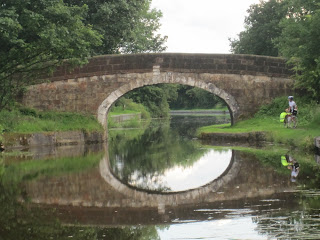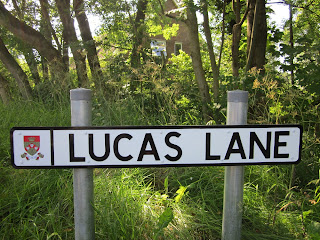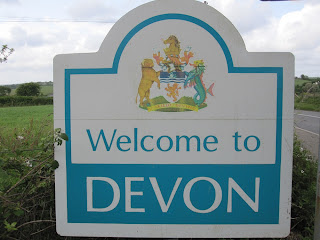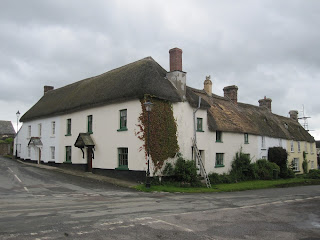In Nantwich we stayed at the Railway Hotel, notable because of the live band playing loud seventies rock that night and also because of the Beatles imagery lining the inside & outside of the building. We could hear the music rather too clearly from our room, though we really enjoyed all the old songs from our era.
On Sunday we rode in hot sunny weather and lunched at another lovely historic market town, Knutsford. Afterwards we had the good fortune near there to witness a canal boat being manoevered through a lock. We also saw lots of cyclists out in the lanes in this area doing Sunday rides.
We then weaved our way north between Manchester & Liverpool via minor roads, country lanes and suburban arterial roads. We had carefully designed our circuitous route to stay away from the heavily-trafficked A roads on the western edge of Manchester.
As with the routes followed on most days, we had downloaded the course to our GPS bike computers so that they beeped & showed the required turns in text on the screen. Greg’s bike computer also displays a detailed map showing exactly where we are, and we are also carrying hardcopy strip maps printed back to back (to save space & weight) showing our route. We also have these maps on our netbook computer.
We passed through or near several smaller towns that had very familiar names (Wigan, Bolton & Warrington) because they either have English Premier League soccer clubs or national super league teams, or both in the case of Wigan. The next day we would also pass close to Blackburn, another EPL town.
At one point we rode along a minor toll road and crossed an attractive bridge over the Manchester to Liverpool ship canal. For the last part of journey to overnight at Chorley, west of Manchester, we rode alongside a canal in the early evening. [Sunday 26/6: distance106 km; climbing 511 m]
Monday was a relatively short but hilly day, again mostly in hot weather. The first part again involved steering clear of busy roads in the Greater Manchester area, chiefly avoiding Blackburn, although we had a great view of the town while riding along a ridge through farmland nearby before heading into the Ribble Valley.
Then we headed up the valley and over some steep hills on the Forest of Bowland (not a forest at all, but rather a mountain moor covered in low-level heather vegetation) and then 'dived' into the village of Slaidburn far below.
We stayed overnight in Slaidburn at the 'Hark the Bounty', an inn that dates from 1310. At dinner we were served by an Australian waitress from Brisbane who had lived in the remote town for 5 years after marrying a Briton. The next morning we chatted with a young New Zealander who had cycletoured from Thailand to Europe over the past 2.5 years and was due to return to NZ in August. [Monday 27/6: distance 63 km; climbing 984 m]




























































